…where east meets west
- Home
- Brief History
- The Greenwich Meridian
- Greenwich
(1675–1958) - Herstmonceux
(1948–1990) - Cambridge
(1990–1998) - Outstations (1822–1971)…
- – Chingford (1822–1924)
- – Deal
(1864–1927) - – Abinger
(1923–1957) - – Bristol & Bradford on Avon
(1939–1948) - – Bath
(1939–1949) - – Hartland
(1955–1967) - – Cape of Good Hope
(1959–1971)
- Administration…
- – Funding
- – Governance
- – Inventories
- – Pay
- – Regulations
- – Royal Warrants
- Contemporary Accounts
- People
- Publications
- Science
- Technology
- Telescopes
- Chronometers
- Clocks & Time
- Board of Longitude
- Libraries & Archives
- Visit
- Search
The Transit Pavilion
Built in 1891 to house a Small Reversible Transit Instrument, the Transit Pavilion occupied a prominent postion in the Courtyard until the end of the 1950s when it was demolished.
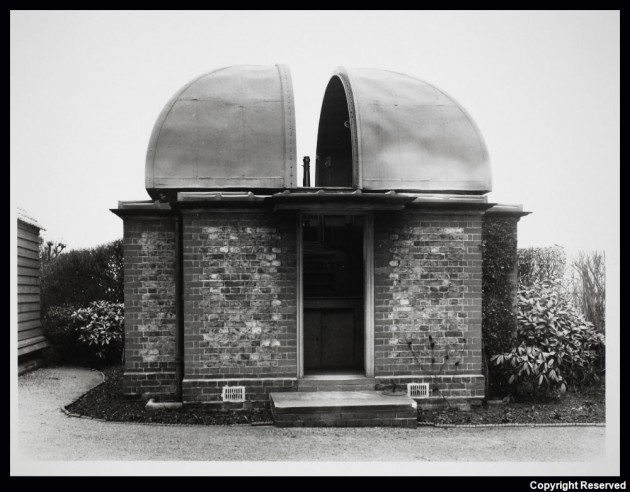
The Transit Pavilion seen from the south in 1929. The centre of the vertical face of the stone slab on top of the step carried the date 1891. The wooden building on the left is the hut housing Cookson's Floating Zenith Telescope. © BT Heritage. Reproduced under the terms of a Creative Commons Attribution-Non-Commercial-ShareAlike (CC BY-NC-SA) licence (see below)
Background to the Pavilion’s construction
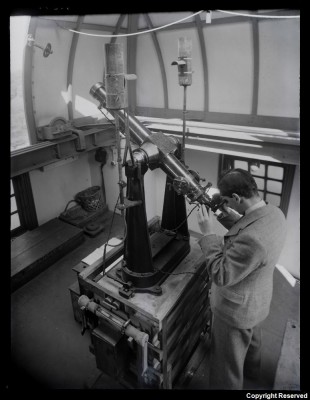
An internal view of the Pavilion in 1935. The instrument shown is Transit D. © BT Heritage. Reproduced under the terms of a Creative Commons Attribution-Non-Commercial-ShareAlike (CC BY-NC-SA) licence (see below)
The centre of the observing pier was 19 feet west and 70 feet north of the Airy Transit Circle. The whole structure was supported on a concrete foundation 1 foot 6 inches deep under the pier and walls and 6 inches deep in the intervening space. The pier was of brick with a capping stone on the top, the total height above the foundation being 8 feet 9 inches. The observing platform was raised 3 feet 3 inches above the floor level serving as a convenient table for the chronograph and signalling apparatus. The space under the platform was used for the storage of batteries. The pier was isolated from the observing platform and floor and protected from accidental jars by a wooden framework round it. The roof consisted of a pair of semi-domes that slid apart to give an opening of 2 feet 6 inches in the plane of the meridian, semi-circular in section.
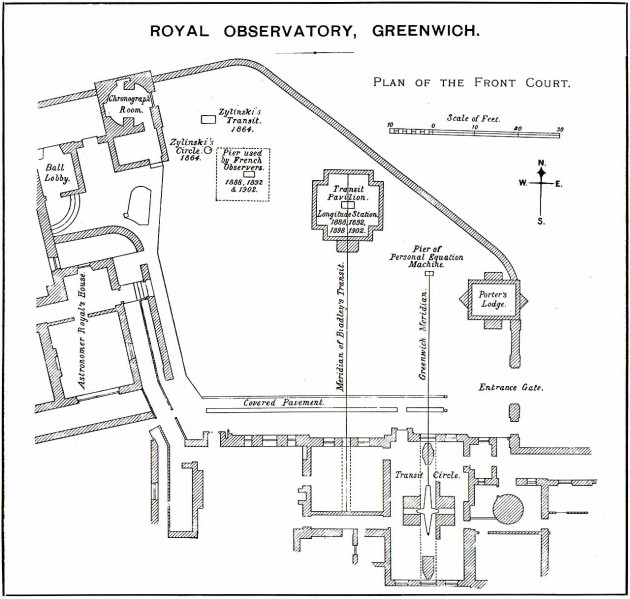
Plan of the Front Court (courtyard) in 1902. Plate VI (detail) from Telegraphic determinations of longitude made in the years 1888 to 1902, HMSO (1906)
Work on the Pavilion commenced in the spring of 1891, but took longer than anticipated because of problems with the semi-domes. Meanwhile, a temporary canvas tent was erected over the telescope until these were finally put in place in October 1891. A small transit telescope from the Transit of Venus expeditions of 1874 and 1882 was mounted on the pier. There are records of Transits B, C and D being used there.
In 1927, time determinations with the Airy Transit Circle ceased, transferring instead to the instrument in the Transit Pavilion. The observatory owned five identical small transit instruments and the one in the Pavilion was occasionally swapped for another.
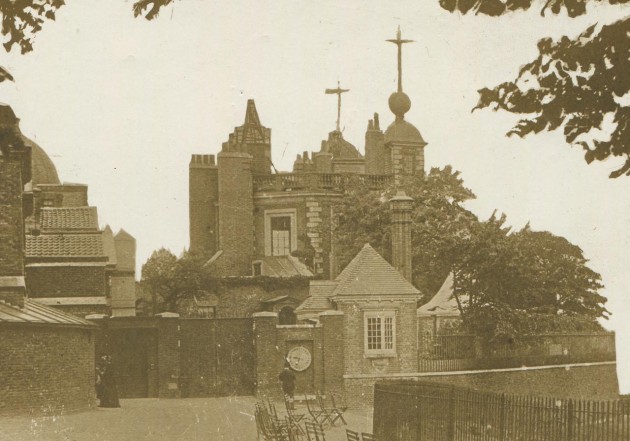
The Transit Pavilion with its temporary canvas roof can be seen to the right of the newly built Porter's Lodge (partly behind the trees). Detail from a postcard by Perkins, Son & Venimore (PS&V)
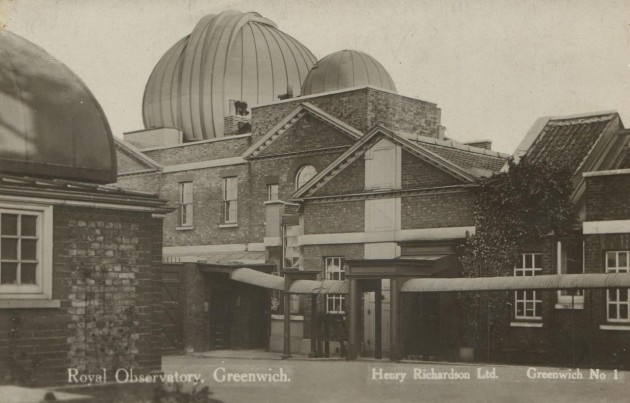
Taken around the start of the twentieth century, this view looking south-eastwards across the Courtyard shows the west side of the Transit Pavilion on the left. The top of the pier used by the French observers in 1888, 1892 and 1902 is just visible in the bottom left hand corner. From a postcard published by Henry Richardson
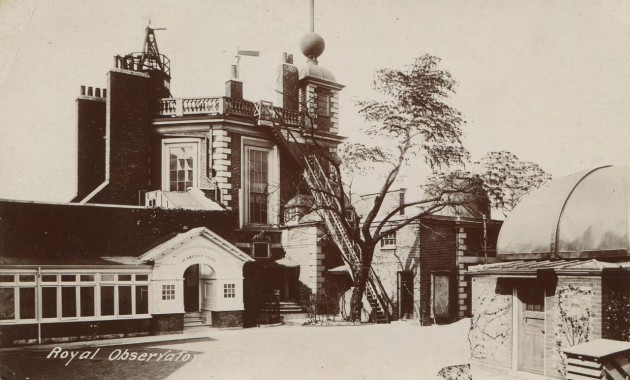
In this slightly later view from about 1907–10 we are looking in the opposite direction towards the north-west with the Transit Pavilion on the right. At bottom right is part of the screen which was erected on 18 July 1896 to re-house the 'Exterior Thermometer' used in conjunction with the Airy Transit Circle. From a postcard published by Perkins & Son
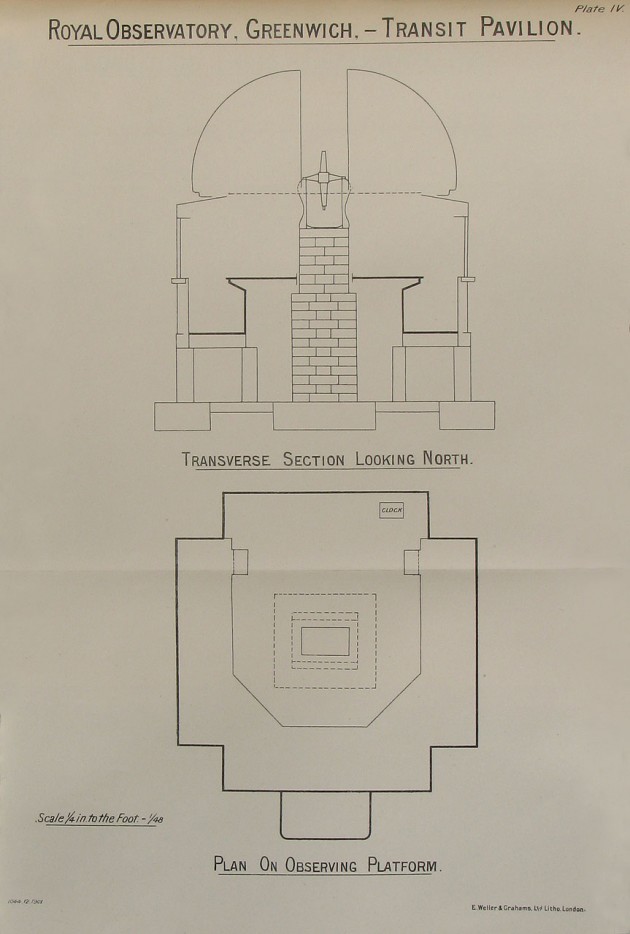
Transverse section looking north and plan on observing platform. Plate IV from Telegraphic determinations of longitude made in the years 1888 to 1902 , HMSO (1906)
War damage
The Battle of Britain began on 10 July 1940. Observations continued with Small Transit B in the Transit Pavilion until the commencement (or announcement?) of nightly attacks on London on 4 September 1940. Transit D took over its functions at the reserve station at Abinger the following day (the first observation being made there on 13 September). The Blitz began on 7 September and the double gates into the courtyard suffered a direct hit on the night of October 15–16. In the blast, damage was caused to the nearby buildings, including the Transit Pavilion, where the main damage was to the dome which was holed in several places. Fortunately, no damage was caused to Transit B, which had already been dismounted (it took over from Transit D at Abinger on 19 October).
In July 1946, small Transit B was brought back into use at Greenwich, but not in the Transit Pavilion which still awaited repair, but in the Altazimuth Pavilion which had been made serviceable in order to accommodate it. The dome was eventually repaired and recovered in 1950/1. Small Transit C was relocated there from the Altazimuth Pavilion on 1 January 1954. It contributed to the Greenwich Time Service until 16 October 1957 when it was superseded by the Photographic Zenith Tube (PZT) at Herstmonceux.
The decision to demolish
In 1954, as the working Observatory was in the process of moving to Herstmonceux, the Department of Works drew up proposals for the future use of the buildings and grounds. They show that at that time, the plan was to retain the Transit Pavilion as part of the proposed Museum of Astronomy and Navigation. During 1959, after much double-checking, a final decision to demolish the Transit Pavilion was made towards the end of the year. Its actual date of demolition is not recorded, but was probably a few months later in early 1960.
Image licensing
The two images at the top of this page are © BT Heritage. They have been obtained from The BT Digital Archives and are reproduced under the terms of a Creative Commons Attribution-Non-Commercial-ShareAlike (CC BY-NC-SA) licence. They are more compressed than the originals.
© 2014 – 2025 Graham Dolan
Except where indicated, all text and images are the copyright of Graham Dolan